SERP Analysis Essentials: How to Read and React to Search Results
Understanding SERP analysis is crucial in SEO. Essentially, SERP analysis involves examining search engine results pages (SERPs) to extract valuable insights. Think of SERPs as the digital landscapes encountered during online searches. Google dominates this terrain, overseeing approximately 90 percent of global searches, according to Oberlo.
Securing a prominent position on these SERPs is vital. It leads to increased organic traffic and a boost in conversions for your website. Organic traffic, highly valued in digital marketing, represents an important goal. It is not only cost-effective but also consists of qualified leads actively seeking your offerings.
However, navigating SERPs today is challenging. Due to their dynamic nature, different types of SERPs can impact the organic traffic you receive differently. Feeling overwhelmed? Don’t fret. Delving into my SERP tutorial will aid in understanding SERP analysis and its intricacies. You will also discover how this analysis can assist you in climbing the search result rankings.
Ready to embark on this informative journey? Let’s explore the nuances of SERP analysis.
Key Points
- Analyzing SERPs involves a thorough evaluation of your website’s performance on search engine result pages, refining your SEO strategy and increasing site traffic.
- SERPs comprise various categories, including paid, organic, video, featured snippets, and the Local Pack.
- Click-through rates for each SERP feature demonstrate significant variation.
- Understanding search intent is essential for crafting content that effectively addresses users’ queries.
- Conducting a competitive analysis helps identify the keywords your competitors prioritize, offering insights into their strategies and empowering you to outperform them in search engine rankings.
Also Read: 14 Essential Free SEO Tools Every Website Owner Should Use
Understanding The Types Of SERP Results
When examining a Google Search Engine Results Page (SERP) or similar pages from other search engines, you encounter two main types of results: organic and paid.
Click-through rates (CTRs) for various features on a Google SERP vary. For example, the initial SERP snippet typically has a CTR of around 42.9%, while the top organic result tends to be about 39.8%. People Also Ask (PAA) queries; however, they generally have a CTR of about 3.0%.
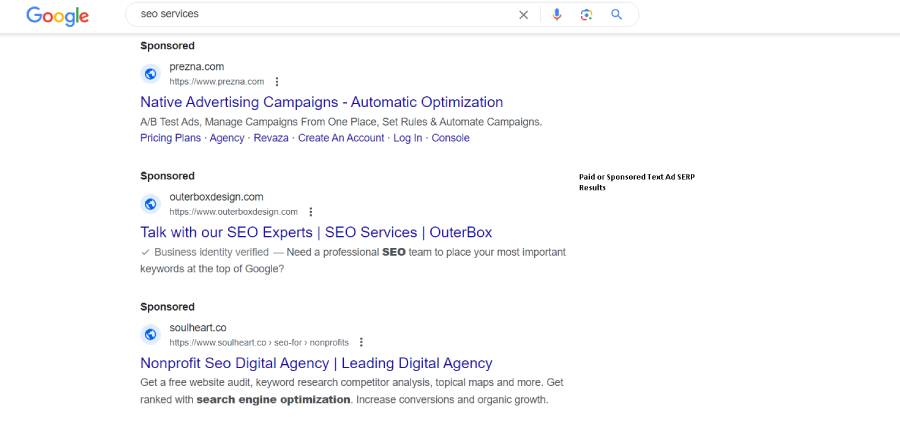
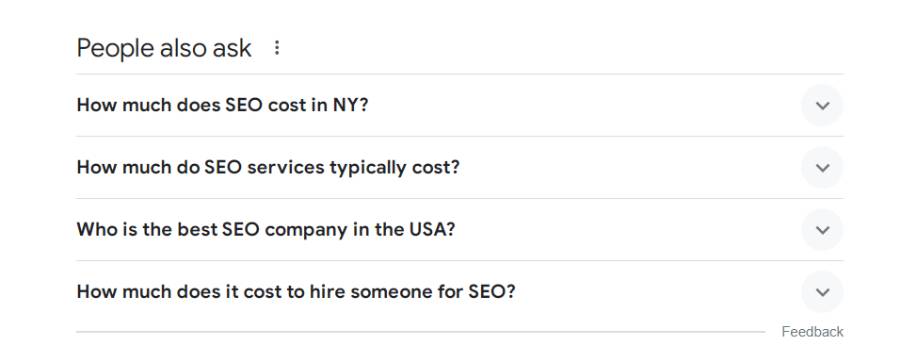
It’s imperative to distinguish between these types of results on a SERP because each category presents its own set of advantages and disadvantages, which collectively influence the overall appearance and effectiveness of the SERP.
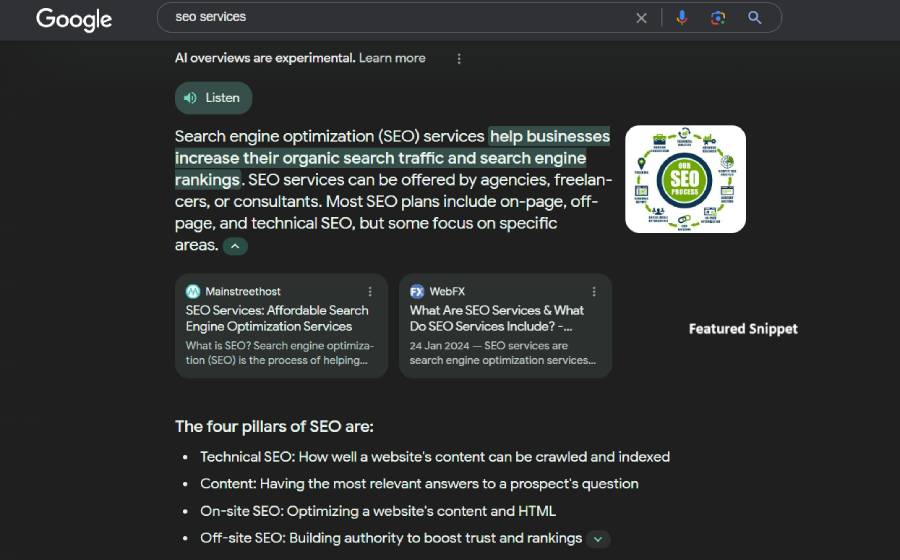

SERPs encompass a wide range of features, including paid advertisements, map results, PAA queries, videos, and text-based organic search results. Understanding the nuances of these elements is essential for marketers looking to harness the potential of SERPs in online marketing strategies.
-
Paid SERPs
Google Ads positions websites at the top of search engine results pages (SERPs) for selected keywords, charging per click. These ads are marked as “Sponsored” and prominently featured. They drive focused traffic, crucial for online exposure. Combining ads with SEO enhances visibility and attracts potential customers, fostering sustained growth in visibility and engagement, thus boosting brand credibility.
The strategic placement of these ads atop SERPs highlights their importance in directing focused traffic to websites. Due to their prime location and immediate visibility, these ads often achieve high click-through rates, providing users with a direct path to relevant content.
Moreover, the capability to target specific keywords ensures ads reach audiences actively seeking related products or services. Consequently, Google Ads is an essential element of online marketing strategies, offering a cost-effective means to enhance online presence and attract potential customers.
For website owners, integrating paid advertising campaigns with search engine optimization (SEO) efforts can yield more significant results. Aligning paid ads with SEO strategies allows businesses to reinforce their presence across various channels and maximize exposure for key search terms. This combined approach not only boosts visibility but also strengthens brand credibility, leading to long-term growth in online visibility and customer engagement.
-
Organic SERPs
In the digital landscape, the standard presentation of search results typically comprises a meta title and description. However, Google has expanded its array of SERP features over time. This evolution has heightened the competitiveness surrounding organic search results, presenting a more complex scenario than that of paid listings.
Despite this heightened competition, there exists an opportunity for website owners and marketers to optimize their presence on the SERPs. By conducting a thorough analysis of search engine results pages (SERPs), individuals can gain insights into the factors influencing visibility and user engagement. Armed with this knowledge, they can strategically position their web pages to garner clicks from users, thereby driving a significant increase in organic traffic to their sites.
-
Featured Snippets
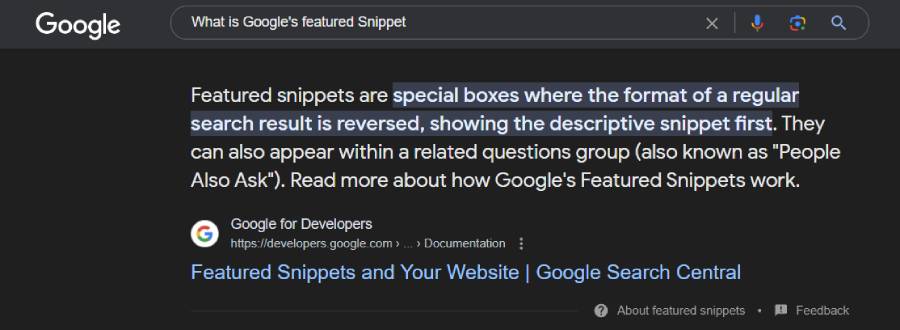
Featured snippets, displayed prominently atop search engine results pages (SERPs), provide immediate access to relevant information, bypassing the need to sift through multiple results. Positioned at the top, they enhance website visibility, attracting more traffic and bolstering brand recognition.
These snippets vary in format—text, tables, or videos—based on the query and available content. Irrespective of format, they furnish quick, concise answers, facilitating user searches.
Crafting high-quality content that directly addresses common industry queries or concerns heightens the likelihood of snippet inclusion. This not only boosts website visibility but also augments overall SEO endeavors, as featured snippets often yield higher click-through rates and increased user engagement.
-
Local Pack

The “Local Pack” is a notable element within search engine results pages (SERPs) that displays three local business listings near the top of the page. These listings include a map pinpointing the businesses’ physical locations. It may also be called the Snack Pack, Map Pack, or Google 3-Pack.
Similar to featured snippets, which offer concise answers to search queries, the Local Pack plays a significant role in improving website visibility and traffic. For local brick-and-mortar businesses, being featured in the Local Pack is crucial for standing out in SERPs. It presents an opportunity for these businesses to attract potential customers actively seeking local products or services, thereby enhancing their prospects for lead generation and sales.
-
Shopping Results
Users searching for products like “best deals on iPhones” encounter a specific search engine results page (SERP) known as Shopping Results, displaying relevant items. To be featured here, businesses must create and maintain a product feed—a structured data file detailing essential information like product names, descriptions, images, and pricing. This proactive step ensures visibility in online shopping platforms.
Creating a product feed involves compiling comprehensive information about each item a business wishes to promote. This means ensuring that all essential product attributes are accurately represented. From the name and description to the product’s visual representation through images, every detail plays a vital role in attracting potential customers. Moreover, precise pricing information is indispensable for transparency and credibility.
Once established, regularly update the product feed to reflect inventory changes. This ensures accurate information for potential customers encountering Shopping Results, enhancing user experience and increasing conversion likelihood.
Businesses maximize visibility by creating and maintaining accurate product feeds for Shopping Results. This boosts the chances of reaching customers and strengthens online presence and competitiveness.
-
People Also Ask
The SERP (Search Engine Results Page) feature mentioned is a common occurrence in online search results and plays a significant role in attracting organic traffic to websites. When users conduct searches on Google, they often encounter a section known as “People Also Ask.” This section typically includes a list of three or four related questions along with their respective answers. However, there are instances where Google may display more than the usual number of questions.

One effective approach for leveraging this feature is to create content that directly addresses the questions listed in the “People Also Ask” section. By doing so, websites can increase their chances of ranking higher in the SERP. This strategy aligns with Google’s goal of providing users with relevant and helpful information, which ultimately contributes to better visibility and increased traffic for the content creators.
-
Generative AI In SERPs
The pervasive influence of AI is increasingly evident across various aspects of our lives, including search engines. Major players such as Google and Bing have swiftly embraced AI’s capabilities.
Generative AI, a sophisticated branch of artificial intelligence, utilizes intricate machine learning algorithms to generate dynamically and present content tailored to individual users’ search queries. Rather than providing static, one-size-fits-all results, search engines can now deliver responses uniquely relevant to each user’s specific needs and preferences.
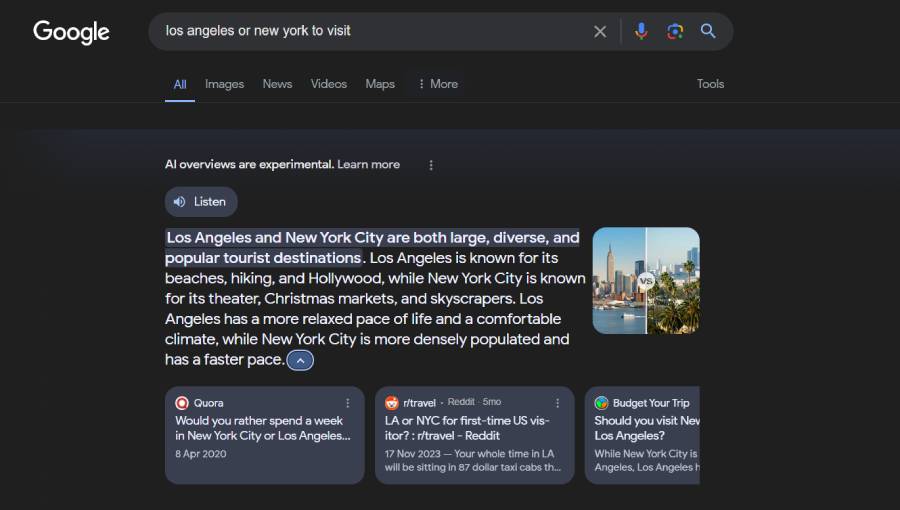
AI, particularly generative AI, is revolutionizing search engines like Google and Bing by personalizing search results to users’ queries, making them more conversational and tailored. This enhances the search experience by offering quicker understanding, fresh insights, and contextually relevant information.
Furthermore, generative AI simplifies product searches by providing concise summaries of suitable products along with descriptions, ratings, prices, and images. Users can also access the most relevant reviews, which are updated hourly through Google’s Shopping Graph. Participation in Google’s Search Labs enables users to explore these advancements firsthand.
Generative AI significantly benefits online shoppers by offering concise product summaries featuring detailed descriptions, ratings, prices, and images. Leveraging Google’s Shopping Graph, it updates search results with the latest reviews, facilitating informed purchasing decisions. Google’s Search Labs allows users to explore AI-driven search firsthand, contributing to its ongoing development.
Understanding The Significance Of SERP Analysis
The connection between Search Engine Result Pages (SERPs) and Search Engine Optimization (SEO) is crucial and cannot be emphasized enough.
SEO plays a vital role in determining the ranking of a website or webpage in search engine results. Through strategic optimization of specific pages, websites aim to achieve higher positions on SERPs, thereby increasing visibility to potential visitors and boosting the chances of attracting organic traffic.
A thorough analysis of SERPs is essential for devising effective SEO strategies. This analysis provides valuable insights into the search intent behind keywords, opportunities for capturing featured snippets, guidance for optimizing content for rich snippets, and intelligence on competitor behavior, including keyword usage and optimization strategies.
Engaging in a comprehensive SERP analysis typically involves several key steps:
- Conducting thorough online searches for relevant keywords to understand the current landscape.
- Analyzing the performance of top-ranking websites to identify patterns and factors contributing to their success.
- Assessing the relevance of selected keywords to the website’s niche or focus.
- Evaluating the feasibility and potential benefits of targeting and ranking for those keywords within SERPs.
By diligently executing these steps and implementing effective SEO tactics, websites can aim to secure prominent positions within SERPs and drive substantial organic traffic to their platforms.
Also Read: Restart SEO: A 4-Step Strategy to make Google Love Your Website
How To Conduct A SERP Analysis For Your Business
Examining SERP involves evaluating different elements like keyword rankings, organic search visibility, featured snippets, and competitor presence on search engine result pages. Understanding how your website is displayed in search results enables you to pinpoint areas for enhancing your SEO approach.
This examination aids in refining your content, meta tags, and overall website layout to enhance visibility and draw in more organic traffic. Should you require assistance with conducting a SERP analysis, a comprehensive step-by-step guide is accessible to assist you through the procedure.
-
Select The Appropriate Tools
To proficiently analyze Search Engine Results Pages (SERPs) in a professional manner, it’s crucial to utilize specialized tools designed for this purpose. Here’s an overview of three such tools:
- Ubersuggest: This tool provides in-depth insights into backlink data and highlights top-performing SEO pages. By leveraging Ubersuggest, you can obtain valuable intel on your competitors’ rankings for high-traffic organic keywords. Additionally, it offers content suggestions and recommends relevant keywords to bolster your SEO approach.
- Mongools SERP Checker: This free tool grants access to local SERPs across a vast array of locations, spanning over 50,000 areas. By inputting your targeted keyword and selecting your preferred location, you can unveil valuable insights into how your website and competitors fare in specific regions. It also aids in pinpointing weaknesses in your competitors’ strategies, giving you a competitive advantage.
Moz Pro’s “Keyword Explorer”: This robust tool is tailored for SERP analysis. Simply input your keyword and location to access comprehensive insights into the competitive landscape. Identify opportunities and fine-tune your SEO strategy effortlessly. The “SERP Analysis” feature is conveniently accessible from the dashboard.
-
Discover Relevant Keywords
To begin, start by thoroughly evaluating the difficulty of keywords and their potential traffic using an SEO SERP tool like Ahrefs. Despite Ahrefs being a paid service, its keyword difficulty tool is accessible without charge.
Following this, it’s crucial to conduct a comprehensive analysis of your competitors to understand the keywords they prioritize and where they may have gaps in their strategy.
Once you’ve gathered this data, proceed to pinpoint the keywords relevant to your specific industry or niche. Ubersuggest is an effective tool for this purpose, enabling you to input your desired keyword and obtain relevant results with a simple search.
Alternatively, you can explore the possibilities offered by AnswerThePublic, a tool designed to provide valuable consumer insights. By utilizing AnswerThePublic, you can uncover fresh concepts for content creation, product development, and service enhancement based on the queries and interests of your target audience.
-
Understand The Concept Of Search Intent
To adequately address users’ requirements, it’s essential to understand their preferences thoroughly and ensure that your content offers pertinent solutions to their queries. It’s vital to identify the underlying motivations driving users’ online searches, commonly known as search intent.
Search intent can be categorized into several groups:
- Informational: Users seeking answers or information on a specific topic or question fall into this category.
- Navigational: Users in this category are looking for a particular website or online destination.
- Transactional: These users are actively seeking to make a purchase or engage in a transaction.
- Commercial: Users in this group are researching products or services, possibly with the intent to make a purchase later.
By closely examining the questions users ask in their search queries, you can better understand their search intent. For example, someone searching for “Best iPhone Deals” is likely interested in purchasing the latest iPhone model, indicating a transactional search intent. Recognizing and addressing these diverse intents can significantly improve the relevance and efficacy of your content in meeting users’ requirements.
-
Examine Your Competitors
Begin by assessing your own standing in the search engine results pages (SERPs) to determine whether your website is visible for your designated keywords.
After this, evaluate your competitors’ performance to ascertain if they are also ranking for the exact keywords. Utilize recommended tools tailored for SERP analysis, focusing on a range of critical metrics including:
- Page quality
- Keyword difficulty
- Click-through rates
- Domain authority
- Engagement
- Conversions
- Backlink analysis
- User experience (Site speed, etc).
Additionally, scrutinize your competitors’ social media presence and ascertain whether they employ paid advertising campaigns targeting specific keywords.
Further enhance your analysis by leveraging Google’s Search Console for valuable insights into click-through rate data and Google’s Keyword Planner for identifying potential keywords.
Upon completing these analytical phases, identify gaps in content and content quality, potential link-building opportunities, and areas where your content may lack relevance compared to your competitors. These findings will form the foundation for crafting a comprehensive SEO strategy.
It’s important to acknowledge that competitive analysis is an intricate process with various nuances. For more in-depth guidance, consider referring to dedicated resources such as specialized blogs focused on competitive analysis, which can provide further insights into understanding competitor activities within the SERPs.
-
Maximize Content Efficiency
Once you’ve conducted your keyword research, it’s essential to understand the criteria for quality content. Google provides a comprehensive guide with questions to assess content quality. Paying attention to Google’s E-A-T guidelines—Expertise, Authoritativeness, and Trustworthiness—is crucial.
After creating high-quality articles, the next step is optimizing them for target keywords. This entails strategically integrating keywords into title tags, headers, and meta descriptions.
Additionally, revisit the earlier competitive analysis to identify optimization opportunities. This may involve developing new content around relevant keywords or topics and integrating newly discovered keywords into existing content.
Besides keyword optimization, Ahrefs suggests exploring other avenues to enhance SERP rankings. This could include optimizing content for features such as video carousels, top stories, and image packs to boost online visibility and reach.
Conclusion
In conclusion, mastering SERP (Search Engine Results Page) analysis is essential for digital marketers and SEO professionals seeking to understand search trends, user behavior, and competitor strategies. SERPs are subject to continuous changes, showcasing various outcomes, including video content and generative AI. Recent developments also include zero-click content and a heightened focus on search intent. Therefore, conducting regular SERP analyses is imperative, ideally every few months.
Adopting a systematic approach, utilizing appropriate tools, and staying updated on search engine algorithms enable individuals to glean valuable insights and remain competitive in the ever-evolving online landscape. Regular SERP analysis, combined with high-quality, relevant content, significantly contributes to attracting the target audience and enhancing online visibility.
With consistent practice and a dedication to ongoing learning, individuals can navigate SERPs proficiently, yielding better outcomes for digital endeavors. Recognizing the importance of SERP analysis allows seamless integration into routines, optimizing website SEO to align with objectives.
FAQs
What tools are available for SERP Analysis?
Several tools can be used for SERP Analysis, such as SEMrush, Ahrefs, Moz, Google Search Console, and Google itself. Each tool provides distinct features, including keyword research, competitor analysis, and SERP tracking.
How can I conduct SERP Analysis effectively?
Begin by identifying your target keywords. Next, scrutinize the top-ranking pages on the SERPs for those keywords. Evaluate factors like content format, word count, backlinks, and user experience. Take note of featured snippets, People Also Ask boxes, and related searches.
What insights can I glean from SERP Analysis?
SERP Analysis offers insights into keyword competition, content gaps, user intent, SERP features, and trends. These insights are instrumental in formulating an effective SEO strategy and optimizing content for improved visibility and engagement.
Can SERP Analysis aid in local SEO efforts?
Certainly, SERP Analysis is pivotal for local SEO. It aids in comprehending how local businesses are displayed in search results, identifying local competitors, and optimizing content for local queries and intent.
SEO Company in lucknow
Comments
Post a Comment